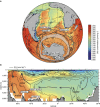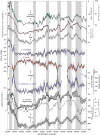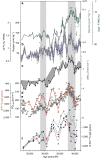Biological and physical controls in the Southern Ocean on past millennial-scale atmospheric CO2 changes
- PMID: 27187527
- PMCID: PMC4873644
- DOI: 10.1038/ncomms11539
Biological and physical controls in the Southern Ocean on past millennial-scale atmospheric CO2 changes
Abstract
Millennial-scale climate changes during the last glacial period and deglaciation were accompanied by rapid changes in atmospheric CO2 that remain unexplained. While the role of the Southern Ocean as a 'control valve' on ocean-atmosphere CO2 exchange has been emphasized, the exact nature of this role, in particular the relative contributions of physical (for example, ocean dynamics and air-sea gas exchange) versus biological processes (for example, export productivity), remains poorly constrained. Here we combine reconstructions of bottom-water [O2], export production and (14)C ventilation ages in the sub-Antarctic Atlantic, and show that atmospheric CO2 pulses during the last glacial- and deglacial periods were consistently accompanied by decreases in the biological export of carbon and increases in deep-ocean ventilation via southern-sourced water masses. These findings demonstrate how the Southern Ocean's 'organic carbon pump' has exerted a tight control on atmospheric CO2, and thus global climate, specifically via a synergy of both physical and biological processes.
Figures




References
-
- Sigman D. M. & Boyle E. A. Glacial/interglacial variations in atmospheric carbon dioxide. Nature 407, 859–869 (2000). - PubMed
-
- Ito T. & Follows M. J. Preformed phosphate, soft tissue pump and atmospheric CO2. J. Mar. Res. 63, 813–839 (2005).
-
- Schmittner A. & Galbraith E. D. Glacial greenhouse-gas fluctuations controlled by ocean circulation changes. Nature 456, 373–376 (2008). - PubMed
-
- Martin J. H. Glacial-interglacial CO2 change: the iron hypothesis. Paleoceanography 5, 1–13 (1990).
Publication types
MeSH terms
Substances
Grants and funding
LinkOut - more resources
Full Text Sources
Other Literature Sources
Miscellaneous

